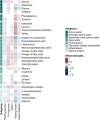A two-sample Mendelian randomization study explores metabolic profiling of different glycemic traits
- PMID: 38459184
- PMCID: PMC10923832
- DOI: 10.1038/s42003-024-05977-1
A two-sample Mendelian randomization study explores metabolic profiling of different glycemic traits
Abstract
We assessed the causal relation of four glycemic traits and type 2 diabetes liability with 167 metabolites using Mendelian randomization with various sensitivity analyses and a reverse Mendelian randomization analysis. We extracted instruments for fasting glucose, 2-h glucose, fasting insulin, and glycated hemoglobin from the Meta-Analyses of Glucose and Insulin-related traits Consortium (n = 200,622), and those for type 2 diabetes liability from a meta-analysis of multiple cohorts (148,726 cases, 965,732 controls) in Europeans. Outcome data were from summary statistics of 167 metabolites from the UK Biobank (n = 115,078). Fasting glucose and 2-h glucose were not associated with any metabolite. Higher glycated hemoglobin was associated with higher free cholesterol in small low-density lipoprotein. Type 2 diabetes liability and fasting insulin were inversely associated with apolipoprotein A1, total cholines, lipoprotein subfractions in high-density-lipoprotein and intermediate-density lipoproteins, and positively associated with aromatic amino acids. These findings indicate hyperglycemia-independent patterns and highlight the role of insulin in type 2 diabetes development. Further studies should evaluate these glycemic traits in type 2 diabetes diagnosis and clinical management.
© 2024. The Author(s).
Conflict of interest statement
The authors declare no competing interests.
Figures





